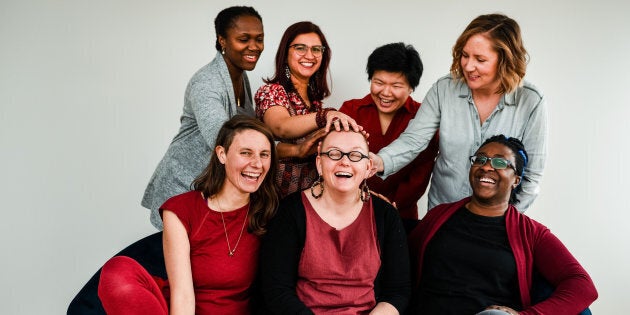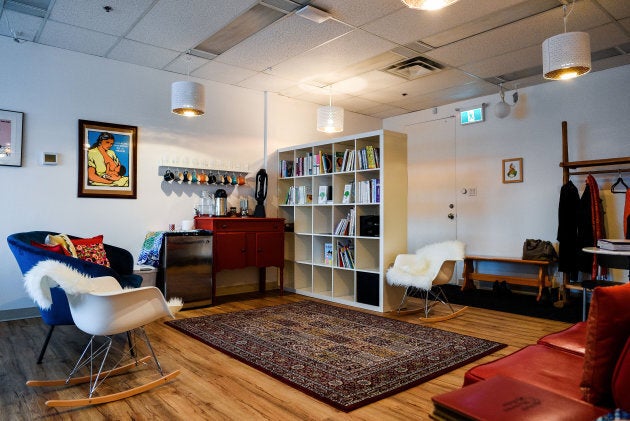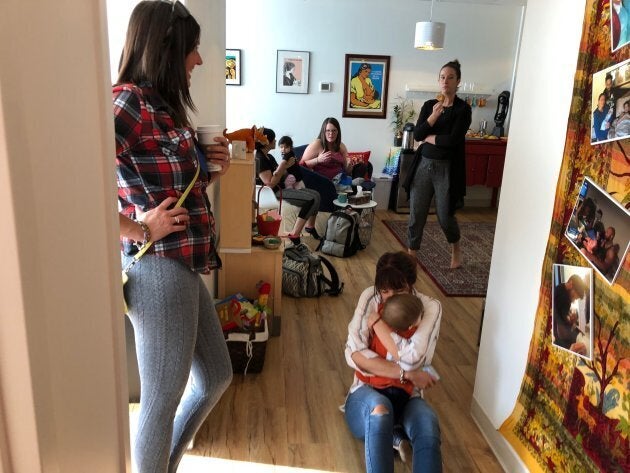
When Melanie Wild and her wife arrived at Red Community Midwives in Calgary for their first appointment, she thought, "This is right who I am, it's where I fit in: these people are going to take really good care of me."
Instead of the hard plastic chairs and fluorescent lights characteristic of many health-care offices, they found handwoven rebozo baby wraps, brightly coloured pillows, and art featuring diverse families. But after meeting three other same-sex couples, they knew the inclusive care offered would go far beyond rainbow stickers and rebozos.
A doula herself, Wild told HuffPost Canada that she knows competent and caring health care is not a given for LGBTQ+ families. Indeed, after crossing out all the places marked "father" on various health and birth-related paperwork for the province, she appreciated her experience at Red Community Midwives even more.
Wild said she loved that midwife Erin Laing didn't treat her family any differently than a straight couple — while at the same time acknowledging that diverse families can have diverse needs.

For instance, using donor sperm or unrelated donor eggs can lead to a slightly increased risk of developing preeclampsia, Laing noted, adding that this risk is true for anyone, not just LGBTQ+ folks.
A registered midwife in a same-sex relationship, Laing wants marginalized families to have access to care providers who aren't just "OK" with their presence.
"There is a difference between [saying] 'I'm open to doing this, and I am actively making sure I'm doing a good job,'" Laing told HuffPost Canada, adding she makes clear that, "If this is how your family is built, these are the things I can do to help."
Red Community Midwives aims for inclusivity in both the basics and the big picture. Their clinic features a huge rainbow heart at the entrance, LGBTQ-inclusive birthing literature, and children's books featuring diverse families and identities. When documenting, they don't use gender pronouns.
"It's not actually hard," Laing said. "It maybe feels slightly uncomfortable for one person, one time. So, if you're a cis man and your 'he' pronoun is this time changed to 'they' ... you don't notice. But if your identity is constantly erased, especially around parenting, then it's really complicated."
WATCH: Photo of gay dads holding newborn will make you tear up. Story continues below.
Language is a powerful tool, so when talking about identities and body parts, Laing makes intentional choices: for example, instead of "mother," in general conversation, Laing says, "birthing person."
Diverse families can have diverse needs
"Just having a rainbow flag on your door isn't enough," Lesley Ann Tarasoff, a postdoctoral research fellow at University of Toronto Scarborough who researches the experiences of LGBTQ+ families seeking prenatal and conception support, told HuffPost Canada.
For instance, there needs to be an understanding that, for many queer and trans people, pregnancy is very deliberate, Tarasoff said. There's a lot of thinking and planning that goes into having children, she said, whether it's through assisted reproduction, adoption, or any of the ways LGBTQ+ people start families.
"We have found that midwives seem to be more LGBTQ-friendly," Tarasoff said, " so a lot of queer and trans people are accessing midwifery care."
For example, the Canadian Association of Midwives released a statement committing to inclusivity in 2015, including trans, gender queer, intersex, and marginalized communities.
That said, Tarasoff noted that individual practices will differ in their training, awareness, and commitment to health equity. Provincial associations also vary in terms of how visibly inclusive they are: the Midwives Association of British Columbia discusses LGBTQ+ care explicitly on their website, whereas the Alberta Association of Midwives website does not, for example.

A non-binary midwife who uses they/them pronouns, Cora Beitel has been actively working to make Canadian midwifery more inclusive of sexual and gender minorities.
"What I'm hearing from a lot of people in my care, is that there wasn't an obvious place where they felt at ease and felt really seen and celebrated for exactly what their family looked like," the co-founder of Strathcona Midwifery Collective in Vancouver said in a previous interview with the Midwives Association of British Columbia.
"Anybody can feel that pregnancy is a vulnerable and tense time in their life and when you're worried about needing to explain why you even need pregnancy care, that can feel really daunting in terms of picking up a phone or filling out an intake form."
The conversation is being moved forward by individuals such as Zena Sharman, a queer parent and LGBTQ+ health advocate who lives in British Columbia. A year after her partner gave birth to their baby, she tweeted a "fan letter" to their midwife that went viral.
In the thread, Sharman, whose partner is non-binary, lists three "profoundly important" things their midwife did. Using correct language and pronouns and listening deeply to the family built trust. Consent was sought before touching or examining Sharman's partner, and collaboration was valued. Lastly, Sharman said their midwife acted as a "good kind of gatekeeper," educating everyone before becoming involved in the birth.
"These relatively simple actions were profoundly important in helping us feel seen and safe," she wrote.
Laing said that caring for LGBTQ+ families requires kind intentions, but also awareness and training — whether that's understanding pronouns, catering to the specific needs of polyamorous families, or teaching a non-birth partner about induced lactation.
"You intentionally put yourself between whatever is targeting that population and those people. So that you can deflect the arrows, and they don't have to all the time," Laing said.
More from HuffPost Canada:
We believe that the HuffPost Canada community should be a safe and welcoming space for all users to engage in a meaningful dialogue, and our community policy is intended to preserve such an environment. Therefore, we have closed commenting on this story, due to overwhelming comments that violate that policy.
Also on HuffPost: